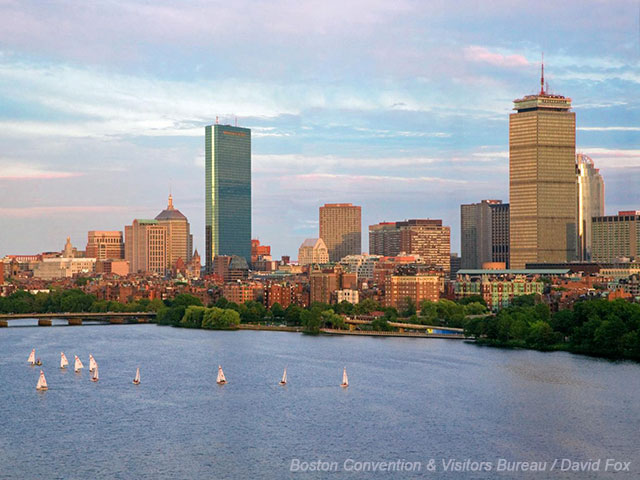Boston Lives Up to Its Nickname in June

Richard Fienberg AAS Solar Eclipse Task Force
With tongue firmly planted in cheek, people have been calling Boston the “Hub of the Universe” since the 19th century. But it’ll be no joke when the AAS convenes its 224th meeting, 1-5 June 2014, at the Westin Copley Place in the city’s historic Back Bay district. Even without the AAS in town, the Greater Boston area occupies a key spot on the astronomical map thanks to its being home to the Harvard-Smithsonian Center for Astrophysics, the Massachusetts Institute of Technology, Boston University, Boston College, Tufts University, the University of Massachusetts, the Chandra X-ray Center, Sky & Telescope magazine, the American Association of Variable Star Observers, and several other institutions with cosmic connections. With so many astronomers already in the neighborhood, the Boston meeting promises to be a particularly dynamic gathering — all the more so because the AAS Solar Physics Division (SPD) and Laboratory Astrophysics Division (LAD) will be meeting with us.
If you can get to Boston the weekend before the main science program gets under way, you’ll have your choice of three hands-on workshops. Tune up your teaching skills with the Center for Astronomy Education’s popular Tier I Teaching Excellence Workshop for Current and Future Astronomy and Space Science Instructors, which runs all day Saturday and Sunday. Learn how your students can become your research partners with the National Optical Astronomy Observatory’s new Sunday-afternoon workshop, Citizen Science in the College Classroom. And get ready for your close-up with the first-ever AAS/National Radio Astronomy Observatory Media Training Workshop, also on Sunday afternoon.
Among the scientific highlights of the meeting are a baker’s dozen plenary presentations, featuring the Kavli lecture by cosmologist David Spergel (Princeton), the Pierce Prize lecture by quasar expert Nadia Zakamska (Johns Hopkins), and talks by the winners of the SPD Hale and Harvey prizes. Hundreds of contributed oral and poster presenters will share their latest ideas and discoveries across the full spectrum of astronomical topics. You can dive deeper into six subject areas via four special sessions (astronomy R&D using picosatellites, observational and theoretical aspects of the multiverse, long-time-domain astronomy, and assorted topics in astrostatistics) and two multisession Meeting-in-a-Meeting programs (gamma-ray constraints on the extragalactic background light and the intergalactic magnetic field, and planets beyond the reach of NASA’s Kepler mission).
Six LAD sessions, covering topics from particles to planets, explore the theme “Bridging Laboratory and Astrophysics.” Two more, convened jointly with SPD, are themed “Bridging Laboratory and Solar Plasma Studies.” SPD has organized no fewer than 14 of its own sessions on topics ranging from the solar interior to the corona and out into the heliosphere. There will also be several Town Hall meetings — always a big draw — where you can hear from, and provide feedback to, senior representatives from NASA, NSF, and the National Research Council’s Committee on Astronomy and Astrophysics.
Every June AAS conference includes the all-important Annual Business Meeting. In Boston we’ll have a changing of the guard as outgoing AAS president David Helfand surrenders the gavel to incoming president Meg Urry. We’ll also welcome other new officers and councilors, hear reports on the Society’s finances and operations, and have a chance to raise and comment on issues of concern to you personally and to the astronomical community more generally. This is also the time and place to propose candidates for the Society’s Nominating Committee, which in turn selects candidates for election as officers or councilors. There will be two vacancies on the Nominating Committee to be filled next year, and the Bylaws specify that we need at least twice that number of candidates to stand for election. Please think about colleagues whose experience and judgment you value, and, after obtaining their consent, come to Boston prepared to put their names forward.
Aside from the meeting itself, there’s lots to see and do in Boston and surrounding areas. The Museum of Fine Arts recently opened a new wing, and the Museum of Science has thoroughly renovated and modernized its planetarium. Symphony Hall is renowned worldwide for its fine acoustics. Enjoy the region’s legendary seafood; stop in at the oddly named but wildly popular Legal Sea Foods to sample a cup of the same “chowdah” served at presidential inaugurations. Walk the Freedom Trail past Paul Revere’s house (the city’s oldest building), sail a boat on the Charles River, or head to Boston Harbor to see the aquarium with its newly renovated main tank or to catch a whale-watching ship. Baseball fans will surely want to visit Fenway Park, the nation’s oldest ballpark and home of the reigning World Series champions (but note that the Red Sox leave for a road trip on June 1st after their Sunday-afternoon game against the Tampa Bay Rays).
You won’t want to miss all the astronomical hubbub in the Hub in early June. Visit our 224th-meeting pages for more information, to submit your abstract, and to register. See you in Boston!


